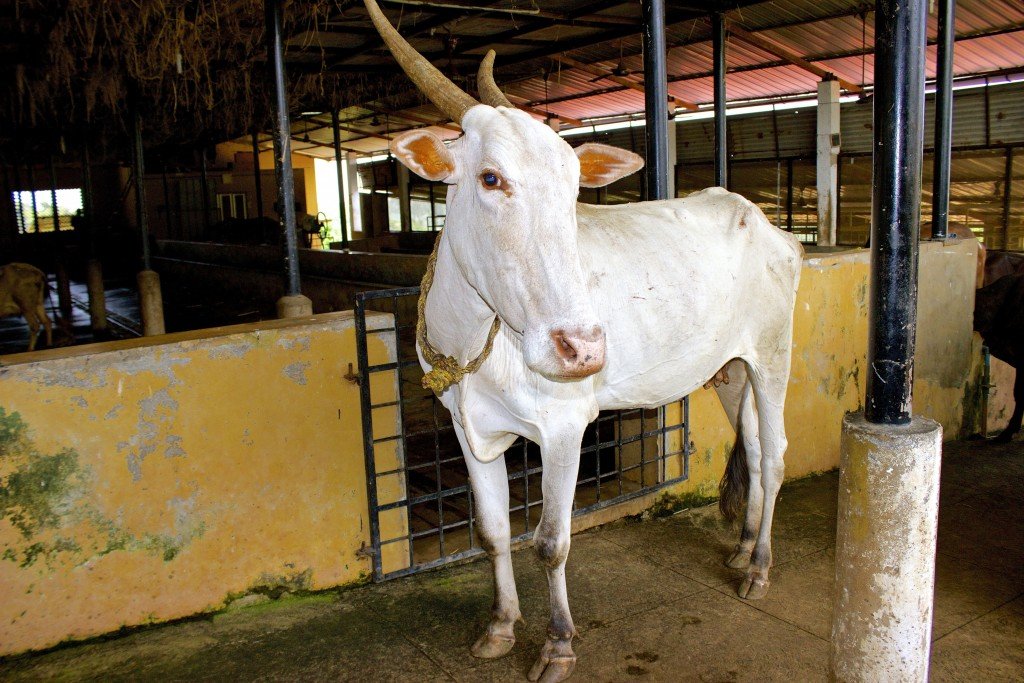Khillari

Khillari cattle originated from the Satara district of Maharashtra and is also a native of the districts of Ahmednagar, Sangli, Kolhapur & Solapur. This breed bears a close resemblance to the Hallikar breed of Karnataka and found in Bijapur, Dharwar and Belgaum districts of Karnataka. The Khillari has about nine subspecies and these has names after their places of origin and qualities, viz: Atpadi, Mhaswad, Pandharpuri, Kosa, Harnya, Daphlya, Bramhani, Dhangiri, Nakli.
The popularity of the bulls of this breed due to good farm use, racing and transportation. The bulls adapt well to the tropical and drought-prone conditions. Classification of Khillari is “medium fast draft” cattle and is famous for its speed, strength and attractiveness. However, there has been a steady decline in its numbers, due to the low milk yield, which is an alternate source of income for farmers.
In the districts of Sholapur and Satara, cultivators breed Khillari since the herd size is small. In Satpura ranges, there are professional breeders called Thillaris who undertake the breeding activity. Government of Mahararashtra selectively breeds Khillari at Hingoli, Jath and Junoni and Government of Karnataka at Bankapur.
Colour:
The Khillari has compact build with a lean and long face, tight drawn skin and clear features. The hairs are fine, short and glossy.
The colour varies according to its types and is generally described as grey-white.Mhaswad and Atpadi Mahal types are grayish white in colour with males having deeper colour over the forequarters and hindquarters and peculiar gray and white spots on the face. Tapti type is white with carroty nose and hooves. Nakali type is gray with tawny or brick-dust colour over the forequarters. New calves have rust-red coloured heads, but this colour disappears soon after birth.
Characteristics:
- The head is long and narrow with long horns sweeping back and upwards in a distinctive bow, and tapering to a fine point. Black colored horns is typical although pink colored horns are common.
- The forehead is long and narrow with a gradual convex bulge toward the horns.
- A groove runs in the center of the forehead from the nasal bridge to center of the head.
- The eyes are set in elongated fashion and are small, prominent and a little bulging. The surrounding thick, wavy skin folds give the eyes a dull appearance.
- The ears are pale yellow colored inside, small, pointed and always held sideways.
- The height is between 4.5 to 5.5 feet and weight is between 350 to 450 kilograms.
- The legs are stout, strong, round and straight with black hooves. The hindquarters are well muscled and the gait is quick and spirited.
- The ribs are well sprung and give the trunk a barrel shape.
- The neck is rather short and the dewlap is light with very little fold.
- The hump in males is firm fleshed and of moderate size.
- The shoulders have tight muscles, well set in and merge smoothly with the body.
- The navel flap, as well as the sheath, is tight and close to the abdomen and the tail almost touches the hock joint.
Conservation Efforts
Government launched a new initiative called Rashtriya Gokul Mission to promote the conservation and development of our Indian breeds of cattle. State Implementing Agency, viz: the Livestock Development Boards (LDBs) implements this initiative.
The scheme allots funds for establishment of Integrated Indigenous Cattle Centre, Gokul Gram. Khillari breed is also a part of this initiative.
We, at Surabhivana, actively support this cause.
Indian Cow Facts
The Khillari has about nine subspecies and these have been named after their places of origin and qualities, viz: Atpadi, Mhaswad, Pandharpuri, Kosa, Harnya, Daphlya, Bramhani, Dhangiri, Nakli.
A new initiative known as the Rashtriya Gokul Mission has been launched by our Government to promote the conservation and development of our Indian breeds of cattle.
The funds of the scheme will be allocated for establishment of Integrated Indigenous Cattle Centre, Gokul Gram.
